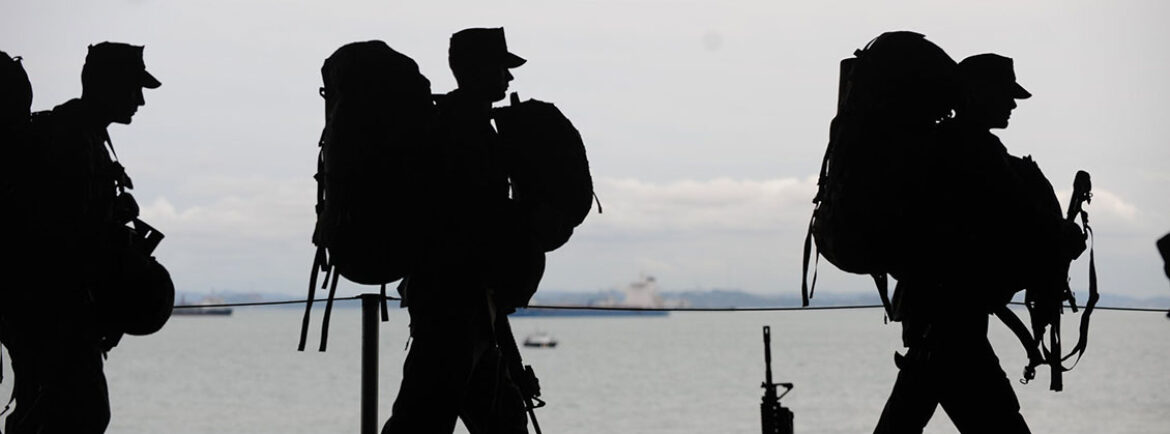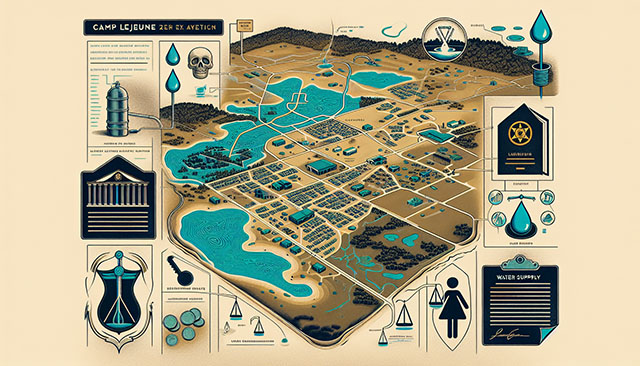
Camp Lejeune
What if the water you trusted was poisoning you? The truth about Camp Lejeune’s toxic water is more chilling than you think.
For more than 30 years, members of the marine corps, their families and many civilians were exposed to toxic chemicals found in the water at Camp Lejeune in North Carolina. The contamination has been linked to serious health issues including various cancers, neurological disorders birth defects and reproductive problems. This article explores the devastating effects that these toxic chemicals have on individuals and families and the steps to file a Camp Lejeune lawsuit if you or a loved one has been negatively impacted as a result of this contamination.
If you or a loved one have been impacted by the water contamination from the military training facility on the Camp Lejeune base individuals can seek compensation for health issues caused by the toxic water. Even if your loved one passed away from one of these conditions decades ago, you may still be able to file a Camp Lejeune wrongful death lawsuit on their behalf.
Key Takeaways
- The Camp Lejeune Justice Act of 2022 allows individuals exposed to toxic water between 1953 and 1987 to file lawsuits, with over 2,089 cases initiated as of September 2024 and a deadline for claims set for August 2024.
- Widespread water contamination at Camp Lejeune, a marine corps base, has resulted from hazardous chemicals include a range of serious health issues, such as various types of cancer (like breast, kidney, and bladder cancer), neurological disorders, reproductive problems, and liver disease.
- Ongoing legal battles regarding the water contamination at Camp Lejeune lawsuit have approximately 20 new Camp Lejeune lawsuits being filed daily as affected individuals seek justice and compensation.
Overview of the Camp Lejeune Contamination Lawsuit

An illustration depicting the Camp Lejeune water contamination lawsuit, highlighting affected areas.
Camp Lejeune, North Carolina, has a history spanning over 80 years, but the most significant events related to water contamination began in 1953. The Camp Lejeune Justice Act of 2022 marks a significant milestone in the quest for justice for those affected by the toxic water at Camp Lejeune. This act, which received bipartisan support, allows individuals who were exposed to the toxic water between August 1, 1953, and December 31, 1987, to file lawsuits for compensation.
The contamination at Camp Lejeune spanned over three decades, from 1953 to 1987, affecting thousands of military personnel, civilians who worked at Camp Lejeune, and their families. Despite the long-term exposure, it wasn’t until 1982 that the presence of hazardous chemicals in the water supply was officially recognized. Since then, the fight for justice has been ongoing, with the first Camp Lejeune lawsuit filed on February 10, 2023.
As of April 23, 2023, over 1,800 lawsuits have been filed, highlighting the widespread impact of this environmental disaster. The deadline for claims filed under the Justice Act is August 2024, giving affected individuals a limited window to seek compensation for the damages they suffered.
The journey towards justice is fraught with challenges, but the determination of Camp Lejeune victims remains unwavering. With the support of experienced legal representation, they continue to fight for their rights and seek the compensation they deserve.
What Happened at Camp Lejeune?
The water contamination issue at marine corps base Camp Lejeune in North Carolina began in the early 1950s, with hazardous chemicals infiltrating the drinking water supply. In 1982, military tests revealed harmful solvents in the water, raising significant health concerns for those exposed. The contamination continued until the most contaminated wells were shut down in February 1985.
The contamination at Camp Lejeune resulted from multiple sources, including leaking underground storage tanks, industrial waste disposal practices, and waste from an off-base dry cleaner. These practices led to high levels of volatile organic compounds (VOCs) in the water supply, including chemicals like tetrachloroethylene (PCE), trichloroethylene (TCE), vinyl chloride, and benzene. The VOC levels in the drinking water exceeded safe limits for an extended period, posing severe health risks to those who consumed it. The toxic water lawsuit against Camp Lejeune is significant in seeking justice for the affected individuals.
Individuals near Camp Lejeune in North Carolina were at risk of exposure to these toxic chemicals from 1953 to 1987. Specifically, the Tarawa Terrace water treatment plant, in particular, was heavily contaminated with PCE due to waste from the dry cleaner. Cleanup efforts began in 1982, but the damage had already been done, leaving a legacy of health problems among Camp Lejeune residents.
The discovery of toxic chemicals in the water supply at Camp Lejeune has had long-lasting repercussions. The affected individuals, including military members, their families and civilians continue to suffer from the health impacts of the contaminated water. Their fight for justice is a testament to their resilience and determination to hold those responsible accountable.
The Chemicals Involved in Camp Lejeune Water Contamination
The water contamination in at Camp Lejeune in North Carolina was caused by several toxic substances, primarily volatile organic compounds (VOCs) that infiltrated the water supply.
The main chemicals involved were:
- Tetrachloroethylene (PCE)
- Trichloroethylene (TCE)
- Vinyl chloride
- Benzene
These chemicals have been linked to a range of serious health issues, including various forms of cancer and chronic diseases.
The contamination was a result of both on-base military activities and off-base industrial practices. The presence of these chemicals in the water supply led to prolonged exposure for the residents of Camp Lejeune, contributing to the health crises they now face. Many individuals report various types of cancer, headaches, confusion and depression in addition to autoimmune diseases and developmental issues in children. These health effects have been linked to prolonged exposure to toxic chemicals found in the base’s water supply.
Understanding the specific chemicals involved and their sources is crucial for comprehending the full impact of the contamination. The following subsections delve deeper into each of these toxic substances, exploring their origins and the health risks they pose.
Tetrachloroethylene (PCE)
Tetrachloroethylene, commonly known as PCE, was one of the primary contaminants found in the drinking water at Camp Lejeune, particularly in the Tarawa Terrace housing area. The contamination primarily originated from a local dry cleaning business off the base, which improperly disposed of its waste, leading to significant PCE infiltration into the water supply.
PCE is a solvent widely used in dry cleaning and other industrial applications. Long-term exposure to PCE has been associated with serious health effects that range from cognitive symptoms such as mental confusion, depression, inability to focus to far more severe diagnosis such as cancer and Parkinson’s Disease.
Trichloroethylene (TCE)
Trichloroethylene (TCE) was another major contaminant in the Camp Lejeune water supply. The peak level of TCE contamination was 43 times higher than the accepted safe level at the time, pointing to the severity of the issue. Key sources of TCE contamination included leaking underground storage tanks and industrial waste from military activities.
TCE is commonly used as a solvent and degreaser on metal equipment, which explains its widespread use and subsequent contamination at a military base like Camp Lejeune. Individuals were exposed to TCE through ingestion, inhalation, and skin absorption, making it a pervasive threat to their health.
The health risks associated with TCE exposure are well-documented and include increased rates of various cancers such as cancer within the kidney, liver, and lungs, in addition to Non-Hodgkin’s lymphoma.
Vinyl Chloride and Benzene
Vinyl chloride and benzene were also found in the water supply at Camp Lejeune. Benzene, a known carcinogen, was linked to industrial processes at the base, while vinyl chloride contamination was associated with the degradation of other chemicals like TCE.
Exposure to these chemicals has been associated with severe health risks, including various forms of cancer, dizziness, fatigue, night sweats, difficulty breathing, heart issues and weight loss.
Health Effects Linked to Camp Lejeune Water Contamination

An illustration showing health effects linked to Camp Lejeune water contamination.
The health effects in North Carolina of the Camp Lejeune water contamination have been devastating, with numerous individuals suffering from serious illnesses due to prolonged exposure to toxic chemicals.
The diseases linked to the contaminated water include:
- various forms of cancer
- birth defects
- cardiac problems
- neurological issues
- organ damage
- behavior disorders
Industrial solvents such as TCE, PCE, and benzene were detected in the water supply, contributing significantly to these health risks. The contamination has had a particularly severe impact on those exposed during pregnancy, with increased rates of birth defects like spina bifida and a higher risk of childhood cancers and neurological impairments.
The health crisis from the contaminated water at Camp Lejeune underscores the importance of the ongoing Camp Lejeune lawsuit, which aims to secure compensation for the health issues caused by the contamination.
Cancers and Chronic Diseases
The Department of Veterans Affairs recognizes multiple cancers as presumptive conditions for those exposed to Camp Lejeune’s contaminated water. Extensive research has confirmed a link between Camp Lejeune water contamination and increased cancer risks overall. This recognition includes cancers such as bladder cancer, kidney cancer, leukemia, and non-Hodgkin’s lymphoma, which have been directly linked to the toxic substances present in the water. Additionally, other cancers such as multiple myeloma, breast cancer, liver cancer, and cervical cancer have also been identified among the affected individuals.
Chronic diseases are another significant concern. Some examples include:
- Parkinson’s disease, which has been linked to a higher risk among veterans exposed to the contaminated water at Camp Lejeune.
- Congenital heart defects, particularly in those exposed to TCE during pregnancy.
- Various chronic conditions associated with exposure to PCE, including liver and kidney injuries and multiple myeloma which impacts bone & bone marrow.
These findings have been crucial in substantiating the claims made by the victims and in guiding the legal processes to ensure they receive the compensation they deserve.
Birth Defects and Reproductive Issues
The exposure to toxic chemicals in North Carolina at Camp Lejeune has been linked to higher rates of birth defects and reproductive issues. One of the most concerning outcomes is the increased incidence of spina bifida, a serious birth defect where the spine does not form properly, among children born to mothers who were exposed to the contaminated water.
In addition to spina bifida, exposure during pregnancy has been associated with other congenital conditions and an elevated risk of childhood cancers. These reproductive issues highlight the multigenerational impact of the contamination, affecting not just those who directly consumed the water, but also their descendants.
The fight for justice encompasses a broader scope, seeking to address the long-term health consequences faced by families affected by this environmental disaster.
Camp Lejeune Justice Act
What Is the Camp Lejeune Justice Act?
The Camp Lejeune Justice Act is a pivotal federal law enacted in 2022, designed to provide a legal pathway for individuals exposed to contaminated water at Camp Lejeune to seek compensation. This act allows victims to file Camp Lejeune lawsuits in federal court, aiming to recover financial settlements for the damages they have suffered. The Justice Act represents a significant advancement in addressing the long-standing water contamination issues at marine corps base Camp Lejeune, offering a new avenue for justice and relief to those affected. By enabling these lawsuits, the act acknowledges the severe health impacts and the need for accountability and compensation for the victims.
Filing a Camp Lejeune Water Contamination Lawsuit

An illustration representing the process of filing a Camp Lejeune water contamination lawsuit.
The Camp Lejeune Justice Act provides a framework for affected individuals to seek compensation for the damages they suffered due to exposure. Eligible claimants include civilian workers, veterans, and their families who resided at the base for at least 30 days between August 1, 1953, and December 31, 1987. The deadline for filing a Camp Lejeune claim is August 2024, giving claimants a limited window to take action through the Camp Lejeune claims unit. There is no Camp Lejeune water contamination class action lawsuit; claims are handled individually.
Filing a claim involves several steps, starting with determining eligibility and gathering necessary evidence including medical records documenting the condition that is linked to the exposure. Claimants must then submit an administrative claim to the Department of the Navy, detailing their exposure and resulting health issues. If the administrative claim is unresolved after 180 days, the claimant can proceed to file a civil Camp Lejeune lawsuit in federal court.
Having an experienced legal representative can significantly ease this process. The Law Office of Paul Mankin, APC, a Camp Lejeune lawyer who specializes in Camp Lejeune cases. Our Camp Lejeune attorneys will help gather all evidence, submit the necessary documentation, and advocate on behalf of the claimants to ensure they receive the compensation they deserve.
Eligibility for Filing Claims
To file a claim under the Camp Lejeune Justice Act, individuals must have resided at the base for at least 30 days during the contamination period. This includes military personnel, civilian workers, and family members who lived on the base. Conditions eligible for claims include significant illnesses caused by the exposure, such as kidney cancer, non-Hodgkin’s lymphoma, leukemia, bladder cancer, and Parkinson’s disease.
Individuals that believe their family member’s passing was a wrongful death and caused by long-term exposure can also file claims on behalf of deceased loved ones if they are legally appointed representatives and can prove a qualifying illness linked to the exposure. Proof of residency can include military records, photographs, and other documents, while medical documentation necessary to establish the qualifying illness.
These criteria ensure that only those genuinely affected by the contamination can seek compensation.
Steps to File a Claim
The first step in filing a Camp Lejeune lawsuit is gathering evidence to support the claim, which is crucial for establishing eligibility. This includes collecting records that explain the condition that is linked to the exposure and proof of residency in North Carolina at Camp Lejeune during the contamination period. The information required in the notice to the Department of the Navy includes the claimant’s name, date of birth, exposure time, illness, and damages.
Once the preliminary investigation and evidence gathering are complete, claimants must submit an administrative claim to the Department of the Navy. This process must be completed before any court claims can be initiated. The government has 180 days to respond to the administrative claim. If the claim is unresolved after this period, claimants can file a lawsuit in federal court.
The deadline to file a Camp Lejeune administrative claim is August 2024. After the administrative process, you may be eligible to file a Camp Lejeune lawsuit. The filing fee for a lawsuit is $400. Following all steps correctly is essential for a successful claim. An experienced legal representative such as our experts at The Law Office of Paul Mankin, APC, can help navigate this complex process effectively.
Gathering Evidence
What Evidence Is Needed to File a Camp Lejeune Claim?
Filing a Camp Lejeune claim requires comprehensive evidence to substantiate the case. Essential evidence includes:
- Medical Records: Documentation of symptoms linked to exposure to the contaminated Camp Lejeune water.
- Residency Records: Proof of time spent at Camp Lejeune, including dates of residence and employment.
- Witness Testimony: Statements from individuals who can confirm the claimant’s exposure to the contaminated water.
- Scientific Studies and Expert Opinions: Research and expert analyses that link the claimant’s diagnosis to the toxic water at Camp Lejeune.
- Expense Documentation: Records of medical bills, lost wages, and other expenses related to the illness caused by the contamination.
Working with an experienced attorney is crucial in gathering and presenting this evidence effectively. All of our experts at The Law Office of Paul Mankin, APC, can help ensure that all necessary documentation is collected and that the Camp Lejeune claims filed are presented in a clear and compelling manner, increasing the chances of a successful outcome.
Legal Representation for Camp Lejeune Cases

Divorce, lawyer (AI-generated).
Navigating the legal landscape of the Camp Lejeune lawsuit can be daunting, making legal representation by Camp Lejeune lawyers highly recommended. Hiring a lawyer can significantly increase the chances of securing compensation and protect the legal rights of victims. Experienced lawyers specializing in these cases understand the intricacies involved and can provide necessary support throughout the claims process.
Choosing the Right Lawyer
Selecting the right lawyer for a Camp Lejeune case is crucial. It is important to ensure that the attorney has a proven record of handling Camp Lejeune lawsuits effectively. Experience in dealing with environmental and toxic exposure cases can make a significant difference in the outcome of the claim.
One way to gauge a firm’s involvement and effectiveness is to check if they have filed any lawsuits related to Camp Lejeune. The Law Office of Paul Mankin, APC, for example, has been actively helping many victims of the water contamination lawsuits.
The government is evaluating these claims, which can affect the outcomes of the lawsuits, making experienced legal representation even more critical.
Assessing Damages and Compensation
The compensation amount in a Camp Lejeune lawsuit is determined by several factors, including:
- The type of illness or injury
- The victim’s living status
- The severity of the health condition
- The duration of exposure
- The impact on the victim’s quality of life
Having legal representation can improve the chances of securing a fair compensation amount.
Reputable law firms typically work on a contingency fee basis, meaning they only receive payment when their clients receive a settlement. This ensures victims can pursue justice without the burden of upfront legal fees, making it accessible for those affected by the Camp Lejeune water contamination.
Latest News and Updates
September 25, 2024 — Status Hearing
On September 25, 2024, a significant status hearing took place to address discovery issues in the ongoing Camp Lejeune lawsuit. The court focused on the National Academy of Sciences’ (NAS) motion to quash a subpoena related to its 2009 report on the contaminated water at Camp Lejeune.
Camp Lejeune Settlement Updates
As of September 2024, a total of 2,089 lawsuits have been initiated under the Camp Lejeune Justice Act. Approximately 20 new lawsuits are being filed daily. Getting Camp Lejeune Settlement Masters what they need, the government has requested a one-week extension in early September.
Settlement amounts offered depend on the type of injury, duration of stay at Camp Lejeune and the time elapsed between exposure and diagnosis. Assessing the value of pain and suffering in these cases is challenging, particularly for serious medical conditions, including Camp Lejeune settlement amounts.
A joint status update on global settlement discussions was filed on October 26, 2023, with judges hoping for a global settlement to be reached as soon as possible. However, the resolution process for Camp Lejeune lawsuits is anticipated to take several years, with trials for bellwether cases expected to take place in 2024 and the first trial anticipated well into 2025, involving Camp Lejeune settlement process.
The lack of clear government response to progress delays adds uncertainty to settlement expectations. However, the ongoing global settlement negotiations provide hope for a resolution that will bring justice and compensation to the victims of the Camp Lejeune water contamination. The current status of Camp Lejeune settlements indicates that the government has allocated significant funds, and the anticipated outcomes suggest average compensation amounts will vary based on factors such as injury type and exposure duration.
Timeline of Key Events in the Camp Lejeune Water Contamination Case

An illustration depicting a timeline of key events in the Camp Lejeune water contamination case.
Camp Lejeune has a history spanning over 80 years, but the most significant events related to water contamination began in the early 1950s when hazardous chemicals infiltrated the water supply. In 1982, military tests revealed the extent of the contamination, leading to the shutdown of the most contaminated wells in 1985. Despite the early recognition, the contamination persisted until 1987, affecting thousands of residents.
The Camp Lejeune Justice Act of 2022 marked a turning point, allowing affected individuals to file lawsuits for compensation. The first Camp Lejeune lawsuit was filed on February 10, 2023, and since then, over 2,089 lawsuits have been filed under the Act, highlighting the significance of Camp Lejeune litigation. The deadline for filing claims is August 2024, adding urgency to the ongoing legal battles.
Trials related to the Camp Lejeune water contamination lawsuit are expected to start as soon as Fall 2024, with bellwether trials playing a crucial role in determining the outcomes of other cases. The timeline of key events highlights the prolonged struggle for justice faced by the victims and underscores the importance of ongoing efforts to hold those responsible accountable.
Summary
The Camp Lejeune water contamination crisis is a stark reminder of the devastating impact of environmental negligence. For decades, thousands of military members, civilian workers, and their family members were exposed to toxic chemicals in their drinking water, leading to severe health issues and a prolonged fight for justice.
Understanding the events that led to the contamination, the specific chemicals involved, and the health effects linked to the exposure is crucial for comprehending the full scope of this disaster. The legal avenues available for those affected, including the steps to file a lawsuit and the importance of legal representation, highlight the ongoing efforts to hold those responsible accountable.
As the legal battles continue, the resilience and determination of the Camp Lejeune victims remain unwavering. Their fight for justice and recognition of their suffering serves as an inspiration and a call to action for greater accountability and environmental protection.
Frequently Asked Questions
Who is eligible to file a Camp Lejeune water contamination lawsuit?
Individuals eligible to file a Camp Lejeune water contamination lawsuit include military members, civilian workers, and their families who lived at Camp Lejeune for at least 30 days between August 1, 1953, and December 31, 1987, and suffer from health conditions associated with that exposure.
What types of health conditions are linked to the Camp Lejeune water contamination?
The Camp Lejeune water contamination is linked to health conditions such as various cancers, Parkinson’s disease, congenital heart defects, dizziness, headaches, weight-loss, organ damage and birth defects like spina bifida. These serious health issues underscore the significant risks associated with the contaminated water.
What are the main chemicals involved in the Camp Lejeune water contamination?
The primary chemicals involved in the Camp Lejeune water contamination are tetrachloroethylene (PCE), trichloroethylene (TCE), vinyl chloride, and benzene, each linked to significant health risks.
What is the deadline to file a claim under the Camp Lejeune Justice Act?
The deadline to file an administrative claim under the Camp Lejeune Justice Act is August 2024. After this date, individuals will be unable to seek compensation.
How can I file a Camp Lejeune water contamination lawsuit?
To file a Camp Lejeune water contamination lawsuit, you must first determine your eligibility and gather necessary evidence, such as medical records and proof of residency. After submitting an administrative claim to the Department of the Navy, if there is no resolution within 180 days, you may then proceed to file a lawsuit in federal court.
